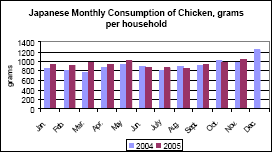



International Egg and Poultry Review
By the USDA's Agricultural Marketing Service - This is a weekly report looking at international developments concerning the poultry industry, this week looking at Japanese Poultry Demand.
Japanese Poultry Demand Shifts to Prepared Poultry
Japan is one of the world’s largest importers of poultry meat. In 2005,
Japan imported 763,636.4 MT of fresh, chilled, frozen and preserved
poultry meat, almost 40% of domestic consumption. Imports were
valued at nearly $2.02 billion. Japan's total broiler consumption in 2006
is projected to be about 1.88 million MT, unchanged from 2005.

Prior to the outbreaks of high path avian influenza (HPAI) in East and
Southeast Asia at the end of 2003, Thailand and China were Japan’s
major suppliers of poultry meat and prepared poultry, followed by Brazil
and the United States. After the HPAI outbreaks in China and Thailand,
Japan banned imports of fresh, chilled or frozen broiler meat from
those countries, later only allowing cooked product from MAFF
designated plants under a bilateral health protocol worked out in 2004.
There are currently 49 plants in Thailand and 35 plants in China
designated by MAFF for exports to Japan of cooked products.
Brazil has become the principle supplier of fresh, chilled, and frozen
poultry meat to Japan. However, U.S. gains were limited due to
constraints on the ability to constantly supply the bulk of "boneless cuts
- leg meat" as Brazil does. An animal health protocol worked out last
year between U.S. and Japan on heat-processed poultry mat and liquid
heat-treated egg products should allow the U.S. to be able to ship the
pre-cooked products irrespective of AI status such as an import ban on
generic meat due to HPAI. To date, the final implementation of the
protocol is pending.
In Japan there is a perception that people can contract bird flu by handling
any poultry meat. This perception triggered Japan’s shift away from all
poultry meat, but especially fresh, chilled, or frozen poultry meats. As
people became aware that cooking meat kills the HPAI virus, consumer
demand for prepared and preserved poultry meat increased, and
Japanese importers responded by increasing the quantity of imported
prepared, pre-cooked poultry meat.
Japan’s total imports of cooked poultry meat preparations initially
dropped sharply from 59 million pounds in December 2003 to 2.5
million pounds in March 2004, in a first response to HPAI outbreaks.
However, Japan’s imports of cooked poultry meat preparations
recovered rapidly to exceed their pre-HPAI outbreaks level.
The increase
of imports of cooked poultry meat preparations were likely needed to
rebalance Japan’s domestic demand for poultry meat, given that lower
quantities of uncooked poultry products (fresh, chilled, or frozen poultry
meat) were being imported. In December 2005, imports of poultry meat
preparations amounted to 73 million pounds, and for all of 2005 total
imports were 44 percent higher than those in 2004.
To view the full report, including tables please click here
Source: USDA's Agricultural Marketing Service - 21st March 2006








